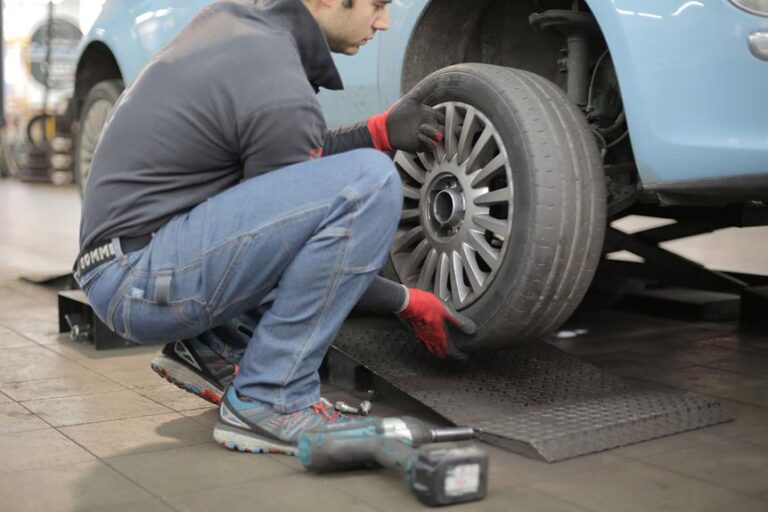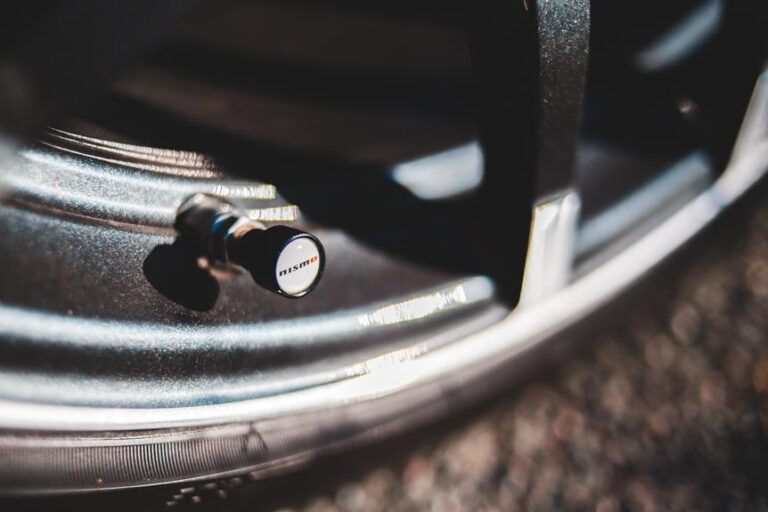Essential Tire Pressure Gauges
In the world of automotive maintenance, ensuring proper tire pressure is paramount to both safety and performance.
Like a compass guiding travelers through treacherous terrain, an essential tire pressure gauge acts as a reliable tool, providing accurate readings and preventing potential mishaps.
This article delves into the types of gauges available, highlights key features to consider, and explores the benefits of using these indispensable devices.
By the end, you will be equipped with the knowledge to select the perfect tire pressure gauge for your vehicle, granting you the freedom to drive with confidence and peace of mind.
Key Takeaways
- Digital gauges offer accurate readings with high precision
- Proper tire pressure improves fuel efficiency and vehicle handling
- Regular tire pressure checks ensure safety on the road and extend tire lifespan
- Accutire MS-4021B, JACO ElitePro, and AstroAI are reliable and highly recommended tire pressure gauge brands.
Types of Tire Pressure Gauges
One of the most commonly used types of tire pressure gauges is the digital gauge, which offers accurate readings with a high level of precision. Digital gauges utilize advanced technology to provide accurate tire pressure measurements. They have an easy-to-read digital display that shows the exact pressure readings in PSI, BAR, or KPA. These gauges are known for their reliability and convenience.
Compared to analog gauges, digital gauges offer several advantages. They provide more accurate readings as they eliminate the need for manual interpretation of the needle position. Digital gauges also tend to have a longer lifespan due to their durable construction. Additionally, they often come with additional features such as backlighting and automatic shut-off to conserve battery life.
Another aspect to consider when choosing a tire pressure gauge is its portability. Portable gauges are compact and lightweight, making them easy to carry around. They are ideal for individuals who frequently need to check their tire pressure on the go. On the other hand, stationary gauges are typically larger and designed to be permanently mounted in a specific location, such as a garage or workshop. These gauges are convenient for regular tire maintenance and can be easily accessed whenever needed.
Ultimately, the choice between digital and analog, as well as portable and stationary, depends on individual preferences and specific needs.
Key Features to Look for in a Tire Pressure Gauge
When considering a tire pressure gauge, it is important to look for key features such as accuracy and durability. Regular tire pressure checks are crucial for maintaining optimal tire performance and ensuring vehicle safety. Many drivers underestimate the importance of maintaining proper tire pressure, leading to potential safety hazards and increased fuel consumption.
One common misconception about tire pressure maintenance is that it only needs to be checked when the tires appear visibly low. However, tire pressure can decrease gradually over time due to factors like temperature changes and natural leakage. Therefore, it is essential to check tire pressure regularly, ideally once a month, to ensure they are properly inflated.
Another misconception is that all tire pressure gauges are the same. In reality, there are various types of tire pressure gauges available, each with different levels of accuracy and durability. To help understand the differences, let's take a look at the following table:
| Type of Tire Pressure Gauge | Accuracy | Durability |
|---|---|---|
| Digital | High | High |
| Analog | Medium | Medium |
| Stick | Low | Low |
As shown in the table, digital tire pressure gauges provide the highest level of accuracy and durability, making them a reliable choice for accurate tire pressure readings. Analog gauges offer moderate accuracy and durability, while stick gauges are the least accurate and durable option.
Benefits of Using a Tire Pressure Gauge
To maximize fuel efficiency and prolong tire lifespan, it is crucial for drivers to regularly check their vehicle's tire pressure using a reliable gauge and maintain the recommended levels. This practice not only ensures safety on the road but also offers several advantages.
Firstly, maintaining the proper tire pressure improves fuel efficiency. Underinflated tires create more resistance on the road, causing the engine to work harder and consume more fuel. By consistently monitoring and adjusting tire pressure, drivers can optimize their vehicle's fuel economy, saving money and reducing carbon emissions.
Secondly, proper tire pressure enhances vehicle handling and performance. When tires are inflated to the correct levels, they provide better traction, stability, and control. This is particularly important during emergency situations or adverse weather conditions, as it minimizes the risk of skidding or losing control of the vehicle.
Furthermore, maintaining the recommended tire pressure promotes even tire wear, extending their lifespan. Overinflated or underinflated tires can wear unevenly, leading to premature tire replacement. By regularly checking and adjusting tire pressure, drivers can ensure that their tires wear evenly, saving money and improving overall vehicle maintenance.
How to Choose the Right Tire Pressure Gauge for Your Vehicle
Having a clear understanding of the features and accuracy levels of different tire pressure gauges is crucial when selecting the right one for your vehicle. Regular tire pressure checks are important for maintaining optimal vehicle performance, ensuring safety, and extending the lifespan of your tires. However, there are common misconceptions about tire pressure gauges that need to be addressed.
One misconception is that all tire pressure gauges provide the same level of accuracy. This is not true. Different gauges vary in terms of their accuracy levels, and it is important to choose one that meets the manufacturer's recommended specifications for your vehicle.
Another misconception is that digital gauges are always more accurate than analog gauges. While digital gauges do offer precise readings, analog gauges can also be accurate if they are well-maintained and properly calibrated. The key is to choose a gauge that is reliable and easy to use, regardless of whether it is digital or analog.
To help you make an informed decision, here is a table comparing different types of tire pressure gauges:
| Type | Features |
| ————- |————-|
| Digital | – Accurate readings
- Easy to read display
- Battery powered |
| Analog | – Durable
- No battery required
- Can be less expensive |
Top Recommendations for Essential Tire Pressure Gauges
A comprehensive review of the top tire pressure gauges on the market reveals the most reliable and accurate options for ensuring proper tire inflation. When it comes to top brands in the industry, the following options stand out: the Accutire MS-4021B, the JACO ElitePro Tire Pressure Gauge, and the AstroAI Digital Tire Pressure Gauge. These gauges are highly recommended due to their accuracy, durability, and ease of use.
One of the most common mistakes people make when checking tire pressure is relying on the built-in gauges on gas station air pumps. These gauges are often inaccurate and can lead to under or over-inflated tires. It is crucial to invest in a reliable tire pressure gauge to ensure proper inflation and tire performance.
The Accutire MS-4021B offers a large and easy-to-read display, as well as a sturdy construction that is built to last. The JACO ElitePro Tire Pressure Gauge features a durable metal body and a glow-in-the-dark dial, making it easy to use in any lighting condition. The AstroAI Digital Tire Pressure Gauge offers a digital display and a sleek design, making it a popular choice among users.
Frequently Asked Questions
Is It Necessary to Check Tire Pressure Regularly?
Regularly checking tire pressure is crucial for maintaining optimal vehicle performance and safety. It ensures proper handling, improves fuel efficiency, and extends tire lifespan. Following tips for proper tire maintenance and using a reliable digital tire pressure gauge further enhances these benefits.
Can I Use the Same Tire Pressure Gauge for All Types of Vehicles?
Different types of tire pressure gauges are available on the market. To choose the right one for your vehicle, consider factors such as the type of vehicle, the desired accuracy, and the ease of use.
Is It Possible to Overinflate Tires Using a Tire Pressure Gauge?
Yes, it is possible to overinflate tires using a tire pressure gauge. Overinflated tires can lead to reduced traction, uneven tire wear, and increased risk of blowouts. Conversely, underinflated tires can cause poor fuel efficiency and decreased handling.
How Often Should I Calibrate My Tire Pressure Gauge?
Calibrating your tire pressure gauge regularly provides numerous benefits, such as accurate readings and ensuring optimal tire performance. The ideal calibration frequency depends on the gauge's manufacturer's recommendations and individual usage conditions.
Are Digital Tire Pressure Gauges More Accurate Than Analog Ones?
Digital tire pressure gauges offer several advantages over analog ones, including increased accuracy. When comparing the two, digital gauges provide more precise readings due to their digital display and advanced sensor technology.
Conclusion
In conclusion, choosing the right tire pressure gauge is essential for maintaining optimal tire performance and safety.
By accurately measuring tire pressure, these gauges help prevent uneven wear, improve fuel efficiency, and reduce the risk of accidents.
Whether it's a digital gauge for precise readings or a simpler analog gauge, investing in a reliable tire pressure gauge is a wise decision for any vehicle owner.
Remember, keeping your tires properly inflated is not just a matter of convenience, but a matter of safety.







